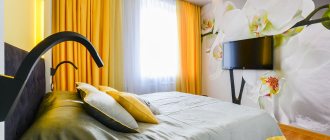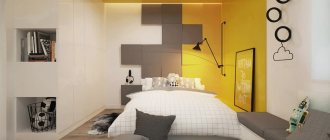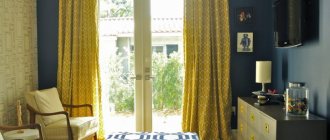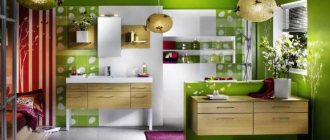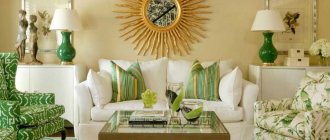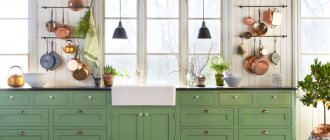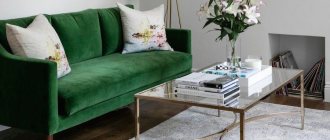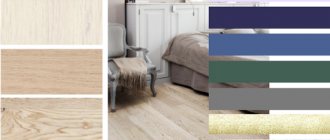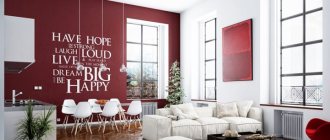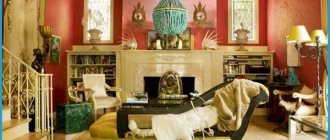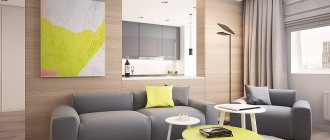Psychology of color
Colors have a strong influence on people, and this is due to the associative series.
To explain our own attitude towards the color yellow, it is enough to remember where it catches our eye most often. And Mother Nature loves him very much. Yellow is the rays of the sun, dandelion fields, sand dunes, ripe bananas, exotic birds and fish. It exudes warmth, attracts attention, and in its brightest shades literally screams and is insolent. This is the difficulty of using yellow color in interiors: it will never agree to play second roles and, being in excess, will quickly get boring, or even completely reduce the design concept to bad taste.
Psychologists have discovered interesting properties of this color:
- invigorates, inspires optimism and sets you up for productive work;
- promotes concentration and memorization of large amounts of information;
- makes any room seem lighter, warmer and more comfortable, visually expands the walls and raises the ceilings.
Sociable, active, expressive, self-confident people, whose lives are filled with movement and bright emotions, feel good in yellow rooms. But for those prone to melancholy, calm and thoughtful natures, yellow walls will put pressure on the psyche, irritate and even provoke headache attacks.
The photo shows a stylish living room, where the yellow color of the walls is repeated in furniture and decorative elements and contrasts well with black details
Photo of yellow color in the interior
Read here Dark colors in the interior - a protest against standards, forward to a new and bold solution (120 photos of new designs)
Did you like the article? Share 
What shades are used in the interior?
The perception of yellow in interior design surprisingly depends greatly on the temperature and saturation of the hue. Pale, cool tones fill the room with air and help create understated, stylish rooms. Warm light yellow shades bring warmth and comfort, bright and dark shades bring dynamics and color.
Along with red and blue, yellow is one of the basic colors of the color palette and cannot be created by mixing. At the same time, the addition of a red pigment “warms up” the yellow and brings it closer to orange, and the blue makes it colder and greener.
A variety of shades, mainly natural ones, are used in the interior:
- solar;
- sand;
- citric;
- canary;
- banana;
- golden;
- cream;
- honey;
- straw;
- corn;
- woody;
- amber;
- mustard;
- saffron;
- curry.
In the photo, fuchsia-colored sofa cushions and the same bouquet highlight the rich greenish-yellow hue of the walls and furniture
Interior with yellow sofa
A yellow sofa in the interior is always appropriate when there are no other bright spots. This looks especially great if the interior design is very light or very dark. Against such a background, the yellow color reveals itself, becomes as noticeable as possible and fills the room with light and warmth.
Photo:
How does it look when finished?
If we consider yellow color as the basis of the design concept, that is, paint all the walls with it, then let it be a calm, discreet shade. Even a convinced optimist or an exalted nature will not bring joy to whole days spent in a canary or banana reality.
When the soul asks for bright colors, and there is also a desire to zone the space or adjust the geometry of the room, it is better to make only one of the walls or a fragment of it yellow, and then play with this decision in furniture, curtains and decorative items.
It is not necessary to use continuous coloring - vertical or horizontal stripes will do. In the first case, you will solve the problem of a low ceiling, and in the second, a room that is too narrow, more like a corridor.
Speaking of the ceiling: it is quite possible to paint it some light shade of yellow or install appropriate stretch fabrics to enhance the feeling of lightness and warmth, but you need to be careful - this technique is only appropriate in spacious rooms with ceilings no lower than 2.7 m .
Yellow flooring is an easy to implement and successful idea for almost any living space, including limited ones, but the smaller the area, the lighter and more natural the tone should be.
In the photo, the bright yellow stretch ceiling in the living room is successfully combined with the same wall decor
What styles is it suitable for?
The richness of yellow shades opens the way for almost any design direction:
- in classics, baroque, gothic and renaissance, warm, rich and rich shades similar to gold rule the roost;
- in rustic styles such as Provence, country and shabby chic, pale, shabby and faded tones would be appropriate;
- in modern trends such as minimalism, loft, hi-tech and avant-garde, bright “artificial” shades of yellow reveal their full potential;
- in natural styles rich in natural textures - Japanese, Moroccan, Egyptian, boho - the same natural tones (straw, sand, curry) are used.
In general, it is quite difficult to imagine a direction for which absolutely all shades of yellow would be alien. This is an amazingly multifaceted color, and if desired, it can be integrated into any design concept.
Examples in the interior of rooms
The living room gives this color probably the widest scope for expression. Pale yellow tones are ideal for walls, while more saturated ones are ideal for furnishings and decor. Since this room is the “face” of the house, feel free to choose all kinds of yellow accessories for it: rugs, flowerpots, paintings, pillows, floor lamps.
A bedroom in yellow tones, especially bright ones, is a dubious decision. This is the color of intelligence, motor activity and ebullient energy, and in the bedroom both the brain and the body should relax. Although, many people like pleasant pastel shades of yellow and do not at all interfere with a restful sleep.
A children's room is traditionally decorated in bright, cheerful colors, especially if we are no longer talking about a baby, but about a tomboyish preschooler. So some rich yellow elements will be quite appropriate, but you shouldn’t completely paint the walls in this color - it will disturb the child and prevent him from getting ready to relax in the evenings.
The kitchen is truly an ideal haven for any shades of yellow, not only the acidic ones, favored by fans of hi-tech and minimalism. Many products have a natural yellowish color (cereals, beans, butter, fruits and vegetables), and the interior in “edible” colors has a positive effect on appetite and inspires delicious cooking.
The bathroom is another suitable springboard for yellow. Entering such a room early in the morning, you will instantly wake up, recharge with vigor and positivity, and set yourself up for a fruitful working day. However, it is better to dilute the yellowness with a white or light gray background.
Surely there are people who, under no circumstances, would decide to use yellow in the design of their home. At the same time, there are devoted fans of this sunny, life-affirming color, ready to surround themselves with it to the maximum. If you are one of them, go for it!
Yellow color in the interior: positive and negative aspects
Yellow is the color of the sun. The lightest and brightest in the color spectrum, one of the least fatiguing colors; stimulates vision and nervous activity.
The very first emotion when you see yellow is joy: it invigorates, cheers and stimulates the activity of the body. Cheerful yellow not only creates an atmosphere of warmth and comfort - it activates the digestion and endocrine systems.
Warm “sunny” shades of yellow almost never carry a negative charge. It can be introduced into the interior using artificial and natural materials (wood, reed, straw in traditional decorations and decorative panels).
Yellow color in the interior brings a feeling of light and joyful mood. Against the background of this color, people's self-esteem increases. Yellow color is very good for communication - it encourages sociability, encourages you to be open and makes it possible to establish favorable contacts with others without obstacles.
Yellow color can have a positive effect on memory and intelligence. It promotes concentration, encourages active thinking and immediate decision-making. With its help, large amounts of information are remembered and nuances are well stored in the mind.
But you need to take into account some “negative aspects” when choosing yellow!
In large quantities, yellow is very tiring: it can be compared to the fact that sooner or later you will get tired of a noisy company, sparkling comedy or fiery dances if you watch and participate for several hours in a row. Cooler shades of yellow can cause a feeling of nausea, unsteady balance, and dizziness on a physical level.
With constant contact with large quantities of yellow, it can become too intrusive, you will want to hide and run away from it. The feeling of aggression, anxiety, and nervousness will gradually increase.
Yellow color in the apartment.
The kitchen will look warm and cozy, yellow color stimulates the appetite.
Living room - yellow is a warm color, the room may seem too hot, a bright atmosphere will be unnecessarily distracting and irritating. But this is the case if you use a bright color and in large quantities.
Bedroom - this color is not suitable if it is overly bright and exciting; such shades of yellow do not allow you to completely relax. If you have yellow wallpaper and bright yellow curtains around you, it will be very difficult to sleep in such a room. However, if you miss the warmth and sunshine, buy yourself a set of yellow bed linen.
Bathroom. In a confined space, yellow can be dangerous - there is a chance that you will feel dizzy and nauseous. But if you limit yourself to just accessories, then the bathroom will become warmer, and in the morning the eye will have something to cling to to get a dose of pep for the next day.
Vacation home. Often the cottage is made of wood, and the yellow color goes very well with wood. Therefore, if you choose yellow for your country house, it will warm it up on autumn and winter days.
Important! All this applies to absolutely pure and bright yellow color. Any other shades of it (paler and transparent, lemon, rich yellow-orange and others) contain impurities of other colors and, accordingly, do not have the influence described above.
